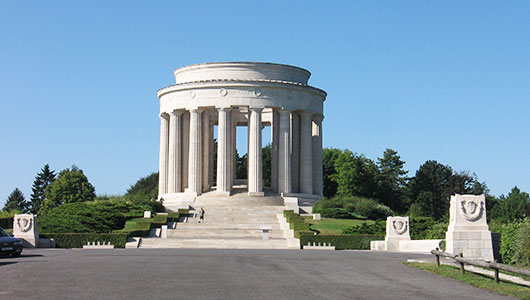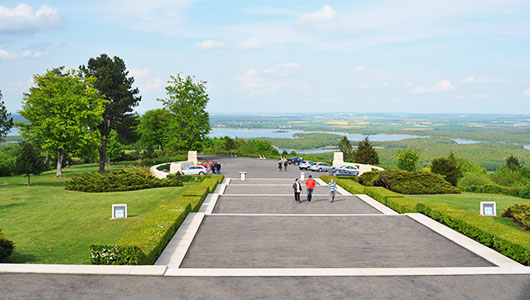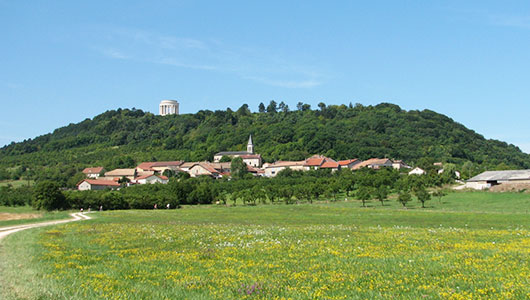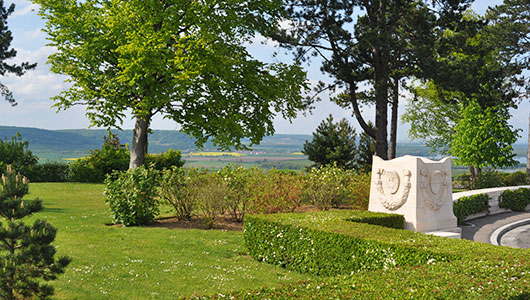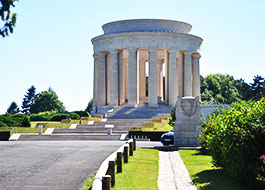Montsec
Durée visite : 30 min
Moyen : Véhicule ou Pédestre
Le site semble attester une occupation dès l’époque gallo-romaine. Différents objets, comme des pièces de monnaie, des sigillées ou des bagues justifient cette hypothèse. Au début du VIIe siècle, a lieu une bataille impliquant le roi d’Austrasie. Des récits la situent à Montsec. En 1051, l’abbaye de Gorze reçoit des mains d’un chevalier nommé Erfo, l’église de Montsec et ses dépendances . Le village est ensuite affranchi, avec le consentement de l’abbé Simon et de sire Gobert d’Aspremont. De ce fait, la localité se trouve sous le régime de la loi de Beaumont. En 1723, l’ancienne chapelle perd son statut d’église paroissiale. Un nouvel édifice est construit au centre du village. L’église et ses biens sont vendus en 1791. Elle renfermait une petite relique de sainte Lucie sa patronne. Bombardée tout au long de la Première Guerre mondiale, la commune subit de nombreuses pertes et déplore la destruction de ses maisons. A la fin du XXe siècle, le village vit de la polyculture et de l’exploitation de la vigne et du bois.
The site seems to attest to an occupation from the Gallo-Roman era. Various objects, such as coins, sigillas or rings justify this hypothesis. At the beginning of the 7th century, a battle took place involving the King of Austrasia. Stories locate it in Montsec. In 1051, the abbey of Gorze receives from the hands of a knight named Erfo, the church of Montsec and its outbuildings. The village is then freed, with the consent of Abbé Simon and Sire Gobert d’Aspremont. As a result, the locality is under the Beaumont law regime. In 1723, the old chapel lost its status as a parish church. A new building is built in the center of the village. The church and its property were sold in 1791. It contained a small relic of Saint Lucia, its patron. Bombed throughout the First World War, the town suffered many losses and deplored the destruction of its houses. At the end of the 20th century, the village made a living from mixed farming and the exploitation of vines and wood.
Die Stätte scheint eine Besetzung aus der gallo-römischen Zeit zu bezeugen. Verschiedene Objekte wie Münzen, Sigillas oder Ringe rechtfertigen diese Hypothese. Zu Beginn des 7. Jahrhunderts fand eine Schlacht mit dem König von Austrasien statt. Geschichten finden es in Montsec. 1051 erhält die Abtei von Gorze aus den Händen eines Ritters namens Erfo die Kirche von Montsec und ihre Nebengebäude. Das Dorf wird dann mit Zustimmung von Abt Simon und Vater Gobert d’Aspremont befreit. Infolgedessen unterliegt der Ort dem Beaumont-Gesetz. 1723 verlor die alte Kapelle ihren Status als Pfarrkirche. In der Mitte des Dorfes wird ein neues Gebäude gebaut. Die Kirche und ihr Eigentum wurden 1791 verkauft. Sie enthielten ein kleines Relikt von St. Lucia, ihrem Schutzpatron. Während des Ersten Weltkriegs bombardiert, erlitt die Stadt viele Verluste und bedauerte die Zerstörung ihrer Häuser. Ende des 20. Jahrhunderts lebte das Dorf von der gemischten Landwirtschaft und der Ausbeutung von Weinreben und Holz.

D’azur à la colonnade circulaire d’argent sur un mont d’or, accompagnée en chef de deux croisettes recroisetées au pied fiché du même, le mont chargé d’une flamme de gueules.
La colonnade circulaire représente le Mémorial érigé par les Etats-Unis au sommet de la butte de Montsec en hommage aux 550.000 boys des USA. Ils avaient repris le saillant de Saint-Mihiel aux Allemands du 12 au 16 septembre 1918. Les croisettes recroisetées indiquent l’appartenance de la localité au Barrois. La flamme évoque sainte Lucie patronne de la paroisse. Elle rappelle aussi la flamme du soldat inconnu de 14-18. (UCGL) Création Dominique Lacorde et Robert A. Louis. Adopté le 20 septembre 2013.
Azure, a circular colonnade Argent on a mount Or, accompanied in chief by two crossroads crisscrossed at the stuck foot of the same, the mount charged with a flame Gules.
The circular colonnade represents the Memorial erected by the United States at the top of the Montsec hill in tribute to the 550,000 boys of the United States. They had taken the Saint-Mihiel salient from the Germans from September 12 to 16, 1918. The crossroads indicate that the locality belongs to Barrois. The flame evokes Saint Lucia, patron saint of the parish. It also recalls the flame of the unknown soldier of 14-18. (UCGL) Creation Dominique Lacorde and Robert A. Louis. Adopted September 20, 2013.
Azure, eine kreisförmige Kolonnade Argent auf einem Berg Oder, begleitet von zwei Kreuzungen, die sich am festgefahrenen Fuß derselben kreuzen, der Berg, der mit einer Flamme Gules aufgeladen ist.
Die kreisförmige Kolonnade stellt das Denkmal dar, das von den Vereinigten Staaten auf dem Gipfel des Montsec-Hügels als Hommage an die 550.000 Jungen der Vereinigten Staaten errichtet wurde. Sie hatten den Deutschen vom 12. bis 16. September 1918 den Saint-Mihiel-Stempel abgenommen. Die Kreuzung weist darauf hin, dass der Ort Barrois gehört. Die Flamme erinnert an St. Lucia, die Schutzpatronin der Gemeinde. Es erinnert auch an die Flamme des unbekannten Soldaten von 14-18. (UCGL) Kreation Dominique Lacorde und Robert A. Louis. Angenommen am 20. September 2013.

Les habitants et les habitantes de la commune de Montsec s’appellent les Montséchois et les Montséchoises.
The inhabitants of the town of Montsec are called Montséchois and Montséchoises.
Die Einwohner der Stadt Montsec heißen Montséchois und Montséchoises.
Les points de visites
.
Au sommet de la colline, à une altitude de 377 mètres, se trouve un monument commémorant les offensives menées par l’armée américaine. Il s’agit du saillant de Saint-Mihiel (à environ quinze kilomètres à l’ouest de Montsec) lors de la Première Guerre mondiale, du 12 au 15 septembre et du 9 au 11 novembre 1918. Le monument, érigé en 1932 en pierre d’Euville, est constitué d’une rotonde à colonnade de style néoclassique. Le centre est occupé par une table d’orientation. Elle est réalisée en bronze illustrant le champ de bataille. Lors de la Seconde Guerre mondiale, le site fut réinvesti par l’armée allemande pour constituer un point de surveillance protégé, puis fut repris par une offensive aérienne alliée accompagnée de bombardements. À cette occasion, le monument fut légèrement endommagé, puis réparé par la suite. Il a été classé monument historique par un arrêté du 7 avril 1975. L’armée française et américaine ont permis la reconquête de Saint-Mihiel. Le monument se veut aussi le symbole de la coopération. Il a été construit sur les plans de l’architecte américain Egerton Swartwout. L’agence gouvernementale American Battle Monuments Commission, à l’origine de l’édifice, continue de l’entretenir.
At the top of the hill, at an altitude of 377 meters, is a monument commemorating the offensives led by the US military. This is the Saint-Mihiel salient (about fifteen kilometers west of Montsec) during the First World War, from September 12 to 15 and from November 9 to 11, 1918. The monument, erected in 1932 in stone d’Euville, consists of a neoclassical style colonnaded rotunda. The center is occupied by an orientation table. It is made in bronze illustrating the battlefield. During the Second World War, the site was reinvested by the German army to constitute a point of protected surveillance, then was taken again by an allied air offensive accompanied by bombardments. On this occasion, the monument was slightly damaged, then repaired later. It was classified as a historic monument by a decree of April 7, 1975. The French and American armies allowed the reconquest of Saint-Mihiel. The monument is also the symbol of cooperation. It was built according to the plans of the American architect Egerton Swartwout. The American Battle Monuments Commission, the government agency behind the building, continues to maintain it.
Auf der Spitze des Hügels, auf einer Höhe von 377 Metern, befindet sich ein Denkmal, das an die vom US-Militär durchgeführten Offensiven erinnert. Dies ist der Saint-Mihiel-Vorsprung (etwa fünfzehn Kilometer westlich von Montsec) während des Ersten Weltkriegs vom 12. bis 15. September und vom 9. bis 11. November 1918. Das Denkmal wurde 1932 in Stein errichtet d’Euville besteht aus einer Kolonnadenrotunde im neoklassizistischen Stil. In der Mitte befindet sich eine Orientierungstabelle. Es ist in Bronze gefertigt und illustriert das Schlachtfeld. Während des Zweiten Weltkriegs wurde das Gelände von der deutschen Armee reinvestiert, um einen geschützten Überwachungspunkt zu bilden, und dann erneut von einer alliierten Luftoffensive mit Bombardierungen eingenommen. Bei dieser Gelegenheit wurde das Denkmal leicht beschädigt und später repariert. Es wurde durch Dekret vom 7. April 1975 als historisches Denkmal eingestuft. Die französische und die amerikanische Armee erlaubten die Rückeroberung von Saint-Mihiel. Das Denkmal ist auch das Symbol der Zusammenarbeit. Es wurde nach den Plänen des amerikanischen Architekten Egerton Swartwout gebaut. Die American Battle Monuments Commission, die Regierungsbehörde hinter dem Gebäude, unterhält es weiterhin.
.

